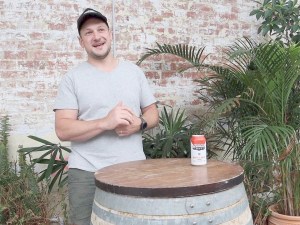
We chat with Travla's head brewer Blake Bowden about crafting an all-Australian lager for all Australians.
The post The little Australian beer with big aspirations appeared first on Beer & Brewer.

We chat with Travla's head brewer Blake Bowden about crafting an all-Australian lager for all Australians.
The post The little Australian beer with big aspirations appeared first on Beer & Brewer.
History and beauty. The Brandywine Valley is steeped in both. With the crisp fall weather, there’s no better time to go on a brewery road trip.
The post The Hills of Beer Are Alive in the Brandywine Valley appeared first on CraftBeer.com.
At several breweries in the UK, people who have learning disabilities have proven themselves to be effective and valuable employees when given the opportunity to show what they can do.
The post Brewers with Learning Disabilities: Equity in the Workplace appeared first on CraftBeer.com.
From brewery hotels to campgrounds, quirky Airbnbs to luxurious resorts, this is your guide to planning a craft beer weekend getaway.
The post AirbnBeers: Breweries with Hotels, Inns, Camping and More appeared first on CraftBeer.com.
 This week Michael Fairbrother joins me from Moonlight Meadery to talk about Cider which has become his top selling beverage. Subscribe on iTunes to Audio version or Video version or Spotify or Google Play Download the MP3 File– Right Click and Save As to download this mp3 file. Your browser does not support the audio […]
This week Michael Fairbrother joins me from Moonlight Meadery to talk about Cider which has become his top selling beverage. Subscribe on iTunes to Audio version or Video version or Spotify or Google Play Download the MP3 File– Right Click and Save As to download this mp3 file. Your browser does not support the audio […] Entrepreneurship and Equity in Brewing provides BIPOC and other underrepresented individuals with opportunities in the craft brewing business.
The post EEB: Opening Doors to a More Inclusive Brewing Community appeared first on CraftBeer.com.
(San Diego,CA) – The Original 40 Brewing Company Head Brewer Zack Kaplan this week releases his first beer Hi Tiki, a sour ale that is available beginning Friday on draft and in cans in the North Park taproom. Hi Tiki is a 5.0% ABV tropical-inspired sour ale brewed with pineapple, coconut, and Sabro hops. It pours bright […]
The post The Original 40 Brewing Releases Cans of Hi Tiki This Friday appeared first on The Full Pint - Craft Beer News.
Summer is here! Melissa Corbin serves up 11 craft-beer destinations and happenings, from the Pacific Northwest to the Deep South.
The post A Toast to Summer: Festivals, Patios, and Benefits appeared first on CraftBeer.com.
(Paso Robles, CA) – After 22 years with the company, Jim Crooks, known as Sour Jim has parted ways with Firestone Walker Brewing and by extension, Firestone Walker BarrelWorks. In the folk lore of Firestone Walker Brewing, Jim Crooks became head of quality control for Firestone Walker long ago, and was involved in the companies […]
The post Longtime Firestone Walker Employee Jim Crooks Parts Ways With Company appeared first on The Full Pint - Craft Beer News.

Max Hämmerle has been appointed head brewer at Philter, with Sam Füss leaving after five years.
The post Philter appoints new head brewer appeared first on Beer & Brewer.
 This week I take a look at the Dunkles Bock beer style from Northern Germany and examine its history and how to brew one. Dunkles Bock is a dark, strong, malty German lager. Dunkles Bock History Bock beer traces its history to Einbeck, a small German town between Kassel and Hannover. Brewing records mentioning bock […]
This week I take a look at the Dunkles Bock beer style from Northern Germany and examine its history and how to brew one. Dunkles Bock is a dark, strong, malty German lager. Dunkles Bock History Bock beer traces its history to Einbeck, a small German town between Kassel and Hannover. Brewing records mentioning bock […] 
Luke Cooper takes up the role after completing his Cert III specialising in brewing at Queensland TAFE.
The post ‘Bush tucker brewer’ graduates to Sobah’s head brewer appeared first on Beer & Brewer.
The roots of American craft beer extend throughout the nation, but the bines of the movement are clearly embedded in the Pacific Northwest.
The post 5 Pacific Northwest Breweries to Please Any Palate appeared first on CraftBeer.com.
Nothing attracts customers to a brewery more than incredible beer. But a close second? An incredible location!
The post Revitalizing Neighborhoods and Reigniting Memories appeared first on CraftBeer.com.
As if the countless American IPA iterations were not enough to satiate a hophead’s palate, a new one—dubbed Cold IPA—lingers bitterly on the horizon.
The post Is Cold IPA Really a New Beer Style (and Does that Even Matter)? appeared first on CraftBeer.com.
(Sausalito, CA) – In a continuing effort to scale regenerative farming practices, Patagonia Provisions and Dogfish Head Craft Brewery have partnered to launch Kernza® Pils, a distinctively crisp and refreshing German-style pilsner beer made with Kernza, a remarkable perennial grain that draws down carbon from the atmosphere and sequesters it in the ground. Hitting shelves […]
The post Dogfish Head and Patagonia Provisions Collab on Kernza Pils appeared first on The Full Pint - Craft Beer News.
From Equilibrium Brewery: High elevation mountain peaks or a perfectly poured slow pilsner, we love all types of snow caps. Made with hops from a mountainous region often dusted with blankets of snow, we are to bring you our latest pilsner, Snow Cap. Pouring a crystal yellow with a billowy head, aromas and flavors of […]
The post Equilibrium Snow Pilsner appeared first on The Full Pint - Craft Beer News.
(Milton, DE) – Amidst the cold and snowy winter season, Dogfish Head Craft Brewery brings the heat, debuting a NEW spring-themed variety 12pk/12oz cans. The perfect mix of warm weather beers, Dogfish Head’s Spring Variety Pack contains a refreshing assortment of four off-centered ales, including fan-favorites 60 Minute IPA, SeaQuench Ale and Namaste. It also highlights the limited-time return of one of the brewery’s most frequently-requested […]
The post Dogfish Head Drops New Spring Themed Variety 12pk appeared first on The Full Pint - Craft Beer News.
Fairbanks, Alaska, attracts visitors hoping to capture sight of the aurora borealis. If you're hunting aurora, these Fairbanks craft breweries should be part of your adventure.
The post Aurora Hunting and Craft Beering in Fairbanks, Alaska appeared first on CraftBeer.com.

Appointment comes as South Melbourne brewery readies to open its new venue later this year.
The post Tim Miller named as Brewmanity’s head brewer appeared first on Beer & Brewer.
From best brewer to best new brewing company, find out who won our industry awards.
The post Beer & Brewer’s 2021 Industry Award winners appeared first on Beer & Brewer.
New initiative to help offset carbon emissions at their Mornington Peninsula site.
The post Hop Nation’s Mind your Head, Mind the Earth fundraiser appeared first on Beer & Brewer.
Multi-million dollar Perth venue will swing open its doors next week in a phased unveiling.
The post Multi-faceted Pirate Life brewpub set to open appeared first on Beer & Brewer.
The prediction comes as EDG shares its plans for an annual supplier awards program.
The post Endeavour expects ‘biggest digital Christmas’ appeared first on Beer & Brewer.
Gage Roads’ latest limited release in a 500ml can is the 4.2% Party Wave Stone Fruit Sour.
The post Kick-start Summer with a Party Wave appeared first on Beer & Brewer.
If you want to know who Averie Swanson is, read her beer labels. “I Am Because We Are.” “The Grace of Maybe.” “At the Still Point of the Turning World.” They point toward a philosophy that has guided her through nearly a decade in mixed-culture fermentation. Her newest venture, Keeping Together, isn’t just her brewery’s […]
The post The Still Point of the Turning World: Overcoming Imposter Syndrome appeared first on CraftBeer.com.
On the heels of the 2021 Great American Beer Festival, we are joined by longtime friend and head brewer of Radiant Beer Co., Andrew Bell. We discuss many things including: – Early days in college, homebrewing and trading on Ratebeer. – Going to school for finance. – Starting at The Bruery at the ground level. […]
The post Podcast EP 213 – Award Winning Brewer Andrew Bell – Radiant Beer Co. appeared first on The Full Pint - Craft Beer News.
Learn how to brew better kettle sours then make your own at home with this all grain recipe.
The post All Grain Recipe: Zilwaukee Bridge Bruin appeared first on Beer & Brewer.